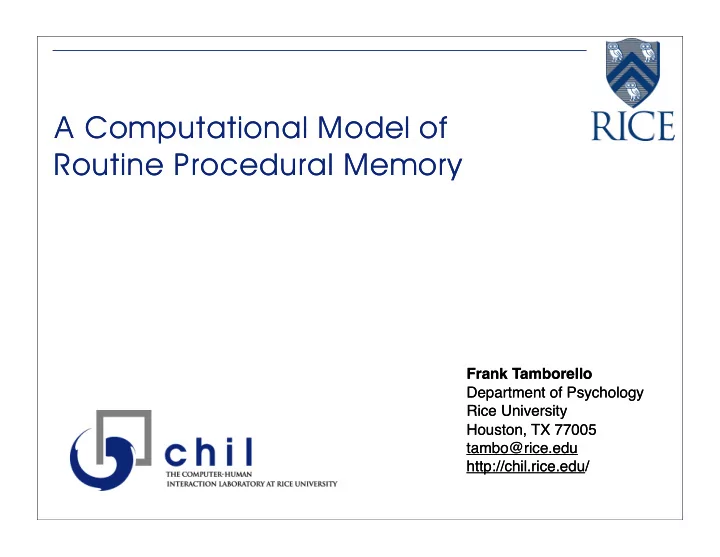

A Computational Model of A Computational Model of Routine Procedural Memory Routine Procedural Memory Frank Tamborello Frank Tamborello Department of Psychology Department of Psychology Rice University Rice University Houston, TX 77005 Houston, TX 77005 tambo@rice.edu tambo@rice.edu http://chil.rice.edu/ http://chil.rice.edu/
Overview Very Brief Introduction Two Experiments, Very Briefly ACT-R Model 2
Context 3
Contention Scheduling Model (CSM) HORIZONTAL VERTICAL THREADS PROCESSING THREADS SCHEMAS Sensory Information SENSORY- External & TRIGGER PERCEPTUAL Internal DATA STRUCTURES Actions BASE PSYCHOLOGICAL PROCESSING STRUCTURES Motivational Attentional resources influence on add to or decrease activation activation values 4
Simple Recurrent Network (SRN) 5
GOMS GOAL: EDIT-MANUSCRIPT GOAL: EDIT-SUBTASK repeat until no more subtasks GOAL: ACQUIRE-SUBTASK ✦ GET-NEXT-PAGE if at end of manuscript page ✦ GET-NEXT-TASK GOAL: EXECUTE-SUBTASK ✦ GOAL: LOCATE-LINE – [select: USE-QUOTED-STRING-METHOD – USE-LINEFEED-METHOD] ✦ GOAL: MODIFY-TEXT – [select: USE-SUBSTITUTE-COMMAND – USE-MODIFY-COMMAND] – VERIFY-EDIT 6
ACT-R Inputs: Knowledge IF-THEN rules (termed “productions”) Declarative knowledge (“chunks”) Subsymbolic parameters Simulated task environment/world Output: Time-stamped behavior sequence 7
Experiment Overview Task is a routine procedure Subjects trained approximately one week before Concurrent working memory task given 8
2 1 ,7 10 6 9, 11 8 3 5 12 4
2 1 , 4 10 3 9, 11 8 5 7 12 6
Mean Total Error Rate Mean T otal Error Rate 0.02 0.04 0.06 0.08 0.12 0.14 0.16 0.1 0 static, intervening subtask procedure change, pre-change Experiment 1 Condition Experiment 1 Condition procedure change, post-change non-intervening semantic control
2 1 , 4 10 3 9, 11 8 5 7 12 6
9, 11 5 6 8 7 1 4 2 3 10 12
9, 11 5 6 8 7 4 2 1 3 10 12
Mean Total Error Rate Mean T otal Error Rate 0.02 0.04 0.06 0.08 0.12 0.14 0.16 0.1 0 static, different-scanner static, same-scanner Experiment 2 Condition Experiment 2 Condition change procedure, pre-change change procedure, post-change static subtask reordering
The Model Model Goal: Simulate error rates across conditions and trial types 4 conditions 14 trial types total not just error generation, but also recovery Highest human SEM error rate = 0.0415 model should do no worse across the board 16
Basic Model Functioning Retrieve Find Move Act Verify Specify next NO Error? action Error Recovery YES Try again to retrieve the action Retrieve another action 17
Procedure Change NO Current step = Retrieve Find Move Act flagged step? YES Verify Specify next NO Error? Retrieve New action Procedure's Step Error Recovery YES Try again to retrieve the action Retrieve another action 18
Mean Error Rate 0.02 0.04 0.06 0.08 0.12 0.14 0.16 0.1 0 static, intervening subtask Experiment 1 Condition procedure change, pre-change procedure change, post-change non-intervening model humans semantic control
Mean Error Rate 0.02 0.04 0.06 0.08 0.12 0.14 0.16 0.1 0 static, different-scanner Jammer, Experiment 2 Condition static, same-scanner model humans change procedure, pre-change change procedure, post-change static subtask reordering
Mean Error Rate 0.02 0.04 0.06 0.08 0.12 0.14 0.16 0.1 0 static, different-scanner Transporter, Experiment 2 Condition static, same-scanner model humans change procedure static subtask reordering
Model Discussion Discrete, hierarchical goals governed basic behavior enabled extensible behavior 22
Basic Model Functioning Retrieve Find Move Act Verify Specify next NO Error? action Error Recovery YES Try again to retrieve the action Retrieve another action 23
Procedure Change NO Current step = Retrieve Find Move Act flagged step? YES Verify Specify next NO Error? Retrieve New action Procedure's Step Error Recovery YES Try again to retrieve the action Retrieve another action 24
2 1, 7 10 6 9, 11 8 3 5 12 4
Model Discussion No quantitative, multi-condition error models in literature Same model mechanisms across 4 between-subjects conditions 14 trial types 26
Future Work Extend model Step-level error Step completion time Model training, too 27
General Discussion Hierarchical, discrete goal representation matters …for changing circumstances …for error recovery …like CSM Botvinick & Plaut ’ s connectionist model too narrow No postcompletion errors No error recovery No adaptation of old procedures to new circumstances 28
Acknowledgments Mike Carissa Chang & Adam Purtee Rick Cooper & Jay McClelland Kristen 29
Thank you! Questions? 30
Recommend
More recommend